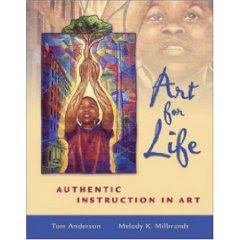- Younger children draw what they know, using scheme (stereotyped ideas that must be overcome so children can draw with accuracy in representation)
- Older children draw what they see
Constructivism (Piaget’s theory of the self-constructed nature of knowledge)
- Children are problem seekers, not problem solvers
- Learners need to discover the means by which to make meaning out of experience and knowledge
- Discovery learning – focusing on creating the possibilities for the child to invent and discover knowledge
- Mental change occurs from action, exploration, and interpretation
- Knowledge is transformative and changing, not objective truth
Changes in children’s thinking correspond with the stages of artistic development
- The sensory-motor period/scribbling stage
- Period of concrete operations/learning how to represent things and ideas through art media
- Period of formal operations/increased intellectual examination (i.e. art criticism, art history, and aesthetics)
Matching the Child's Natural Way of Thinking
- The task in the early years of school is to put the materials into the child's natural way of thinking-using the senses along with concrete objects
- Knowledge is acquired in a spiral manner-revisited every year
Role of Social Context
- Encourage students verbal interaction with peers to develop thinking about issues
- This encourages students to confront the views of others and defend their own ideas
- Cooperative learning - requires students to be dependent on each other to achieve learning goals
Role of the Emotions: The Intuitive and the Nonrational
- Emotions guide actions and are shaped by them
- Elementary age children must develop an emotion-filled eagerness to learn new skills and win recognition through successful performance, or the child risks developing a sense of failure and inferiority (from Erickson)
- We "know" about things with both ideas and feelings
- Art can give psychological voice to the creator's coping strategies
Transformation
- As art is made, the brain's different mental functions - the rational, the intuitive, and the irrational - are brought together
- Transformation and novelty are important goals of education
- Educational task is to keep the playful analogical thinking growing, rather than dwindling, throughout the school year
Children's Similarities and Variability
- Scribbling - preschoolers begin with random, haphazard marks and then move on to explore different kinds of scribbles, acquiring more control
- Scribbling is universal across cultures
- Stage theory should only be used as a descriptive not a prescriptive device
- U-Shape Decline - slump in creativity that can occur around ages 8-11, probably due to child's inner demand for photographic realism






No comments:
Post a Comment